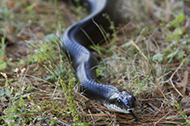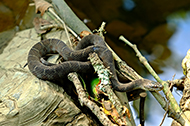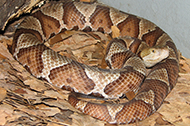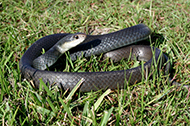Jake the Snake and Friends Visit NIEHS
By the Environmental Management System, Safety and Environmental Protection Branch, OM, Bill Willis and John McLamb
June 5, 2014
One of the benefits of working here at NIEHS is the ability to take a break outside and stroll around the lake. With the onset of warm days and nights, it’s not usual to see more animals active in our natural areas. This is certainly true of reptiles and amphibians. These critters share our environment and are an important part of the ecosystem in which we live and work. Our campus offers a wide range of habitats, from the lake and wet marshy areas to upland pines and hardwoods. In order to share the joy of seeing these animals, we should be mindful that they are wild animals and should not be disturbed or harassed. Being a Federal Property we are also subject to some of the same regulations that cover a national park, in that no plant or animal material is to be taken or harmed without prior authorization.
That being said we all need to take a moment to learn about the species that we might encounter on our walks. The EAAC is preparing a nice handout on Reptiles of NIEHS that will be printed in a couple of weeks. It will provide pictures for easy identification and will be available from the EAAC display in C-mall. Posters showing pictures of North Carolina’s dangerous plants and animals will also be placed on the display. Please plan to visit and learn how to identify these creatures.
Four snakes that have been seen at NIEHS are: the black rat snake, the northern water snake, the copperhead, and black racer.
Black Rat Snake

The most common snake here is the nonpoisonous black rat snake. The adult is black with a gray-white chin and belly. The young will be patterned on their back, making them hard to identify. These snakes are often seen on the forest floor and possibly draped in a shrub or small tree. They eat rodents, other snakes, birds, and small animals. A black rat snake will usually flee if approached, but if cornered may vibrate his tail and strike. Giving him space is best. This snake’s temperament can vary greatly.
Northern Water Snake

This nonpoisonous snake is found near lake edges, on rocks sunning or in the water with only its head protruding. Some snakes have dark patterns while others have distinctive reddish brown markings. The darker version is often mistaken for a water moccasin. If you see one, there’re usually more around in the water. They feed on fish, amphibians and other small prey. It’s best to leave them alone since they do have a temper and smell bad.
Copperhead

This is a beautiful but poisonous snake that might be seen on the path or in the woods. The hour-glass markings on the back, the large thick triangular head, and the slit pupils characterize this snake. In the snake world, it’s not known to be a speedster so be patient and it usually moves on. This snake is not known to be a climber, so look down. It too feeds upon small mammals. If you’re interested in how it feels to be bitten, Jerry Phelps can fill you in.
Black Racer

This nonpoisonous snake can be mistaken for a rat snake but it’s slimmer, shinier, and the only white is under the chin. The head is usually held up as if on alert. These snakes are seen in woodlands, meadows, bushy areas, and along NIEHS employee walkways. They eat rodents, other snakes, birds, and small animals. They are not aggressive and will retreat rapidly as their name implies. If threatened they coil, vibrate their tail and strike out to defend themselves.
Aquatic birds, raccoons, and other predators, such as King Snakes, can keep other snakes in check.
The snakes in turn keep rodents and small critters under control.
When outside, please be aware of your surroundings and watch where you’re stepping. You’re much more likely to step into a hole than on a snake.
Snakes that encroach too closely on our buildings will be relocated to other, less inhabited parts of the campus.
A more complete list of poisonous and nonpoisonous snakes in North Carolina can be found at: NC Snakes.



